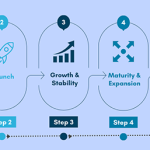There are five different phases of company growth that a business will experience within it´s life cycle. According to Statista, in 2021, there were a total of 333.34 million active companies worldwide. Every company has it´s own history and evolution, but they generally follow a similar path in the company lifecycle.
Some companies may skip some stages, while others follow the cycle more chronologically. In this article, we refer to the standard process of business growth.
The business lifecycle involves several phases over time. Usually, the process consists of 5 stages: idea and development, launch, growth and stability, maturity and expansion, and lastly, decline.
The phases of company growth
1. The first phase of company growth: idea and development
In this stage, the company presents the initial, conceptual business idea, then identifies an existing problem, a solution and who it will benefit.
After the identification of these key points, the following step is to validate the product or service the company offers in order to observe its acceptance and profitability in the market. Note that in this stage, the product or service is basic and has not reached it´s full customer satisfaction potential.
You may be interested in reading our article: The Role of a Business Owner
2. Launch
In this phase, after the validation of the product, it is perfected it according to customer feedback until it is ready to enter the market.
Initially, sales tend to be low but eventually, they slowly increase.
Companies focus marketing towards their target consumer market by advertising their competitive advantages and value propositions. However, since revenues are low and initial costs are high, companies are vulnerable to losses in this stage.
3. The growth and stability phase
In the growth and stability phase, companies experience a rapid increase in sales. Normally, as sales increase, companies begin to profit as they exceed the break-even point. However, it is essential to note that revenue and the number of sales do not always correlate and hence, profits increase at a slower rate than sales. Despite this, soon, cash flow becomes positive, representing a surplus of cash and hence providing stability for the firm.
You may be interested in reading our article: Ensuring Stability, Synergy & Success
4. Maturity and Expansion
Companies now have a solid business structure, lower operational costs, more effective processes and stable sales figures.
However, it is important to take into account that many companies that have already proven that their business model is profitable, extend their business model during this phase. They reinvent themselves and invest in new technologies and emerging markets. This allows these companies to reposition themselves in more dynamic industries and refresh their market growth.
5. The final phase of company growth: decline
Finally, we arrive at the last of the phases of company growth. The maturity and expansion phase is successful once the company has been making steady profits for consecutive years. While some companies continue to increase gross revenue at a continuous rate, others struggle to do so.
Two choices then face entrepreneurs: push to expand further or go out of business. If they decide to expand further, they must go through the expansion stage. The question is, however; can the company continue to grow? Is the purchase of another company necessary? Are there enough expansion opportunities? Is the company financially stable enough if the expansion fails?
Many companies at this stage also attempt to move forward through a sale. In this case, the most important thing is to prepare for the sale of the company before starting the process.
Analysing the company´s strengths and weaknesses and increasing its value can be key to maximising the company´s selling price.
It´s important to recognise that not all companies go through the same lifecycle. There will be some that change the order of the cycle and others that only go through a few of the stages. It is important the company is prepared to take the right steps in whichever situation faced.
You may be interested in reading our article: The Business Valuation Process
If you need advice for the sale of your company, contact us now with no obligations. We will help you prepare and guide you step by step, to ensure you get the maximum benefit from the process.





